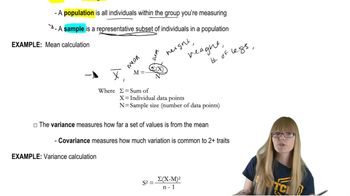New allopolyploid plant species can arise by hybridization between two species. If hybridization occurs between a diploid plant species with 2n = 14 and a second diploid species with 2n = 22, the new allopolyploid would have 36 chromosomes. What type of isolation mechanism is most likely to prevent hybridization between the allopolyploid and the diploid species?
Table of contents
- 1. Introduction to Genetics51m
- 2. Mendel's Laws of Inheritance3h 37m
- 3. Extensions to Mendelian Inheritance2h 41m
- 4. Genetic Mapping and Linkage2h 28m
- 5. Genetics of Bacteria and Viruses1h 21m
- 6. Chromosomal Variation1h 48m
- 7. DNA and Chromosome Structure56m
- 8. DNA Replication1h 10m
- 9. Mitosis and Meiosis1h 34m
- 10. Transcription1h 0m
- 11. Translation58m
- 12. Gene Regulation in Prokaryotes1h 19m
- 13. Gene Regulation in Eukaryotes44m
- 14. Genetic Control of Development44m
- 15. Genomes and Genomics1h 50m
- 16. Transposable Elements47m
- 17. Mutation, Repair, and Recombination1h 6m
- 18. Molecular Genetic Tools19m
- 19. Cancer Genetics29m
- 20. Quantitative Genetics1h 26m
- 21. Population Genetics50m
- 22. Evolutionary Genetics29m
21. Population Genetics
Allelic Frequency Changes
Problem 40b
Textbook Question
Divide the contents of a large bag of different-colored candies randomly and approximately equally among the members of the group. Do not pick specific candy colors, but simply empty the contents of the bag onto a table and quickly divide the pile. If you are doing this exercise by yourself, divide the contents of the bag into five piles. Tabulate the total number of candies of each color in the original bag by combining the numbers from each person. Use these numbers to determine the frequency of each color in the original bag.
 Verified step by step guidance
Verified step by step guidance1
Step 1: Begin by emptying the contents of the bag onto a table. Ensure all candies are visible and accessible for division.
Step 2: Randomly divide the candies into equal piles. If working alone, divide the candies into five approximately equal piles. Avoid selecting candies based on color to maintain randomness.
Step 3: Count the number of candies of each color in each pile. Record these counts systematically for each pile.
Step 4: Combine the counts from all piles to determine the total number of candies of each color in the original bag. Add the counts for each color across all piles.
Step 5: Calculate the frequency of each candy color by dividing the total number of candies of each color by the total number of candies in the bag. Use the formula: , where is the total count of a specific color and is the total number of candies.
 Verified video answer for a similar problem:
Verified video answer for a similar problem:This video solution was recommended by our tutors as helpful for the problem above
Video duration:
2mPlay a video:
Was this helpful?
Key Concepts
Here are the essential concepts you must grasp in order to answer the question correctly.
Random Sampling
Random sampling is a technique used to select a subset of individuals from a larger population, ensuring that each member has an equal chance of being chosen. In the context of dividing candies, this method helps to avoid bias in selection, allowing for a more representative distribution of different colors. This concept is crucial for understanding how to achieve an equitable division of the candies.
Recommended video:
Guided course

Non-Random Mating
Frequency Distribution
Frequency distribution is a statistical method that shows how often each value occurs in a dataset. By tabulating the total number of candies of each color, one can create a frequency distribution that illustrates the relative abundance of each color in the original bag. This concept is essential for analyzing the results of the candy division and understanding the overall composition of the bag.
Recommended video:
Guided course

Natural Selection
Proportional Representation
Proportional representation refers to the idea that the distribution of items (like candies) should reflect their original proportions in the population. When dividing the candies, it is important to ensure that each pile maintains a similar ratio of colors as found in the original bag. This concept helps in assessing whether the division was fair and representative of the initial assortment.
Recommended video:
Guided course

Mathematical Measurements
Related Videos
Related Practice
Textbook Question
386
views


